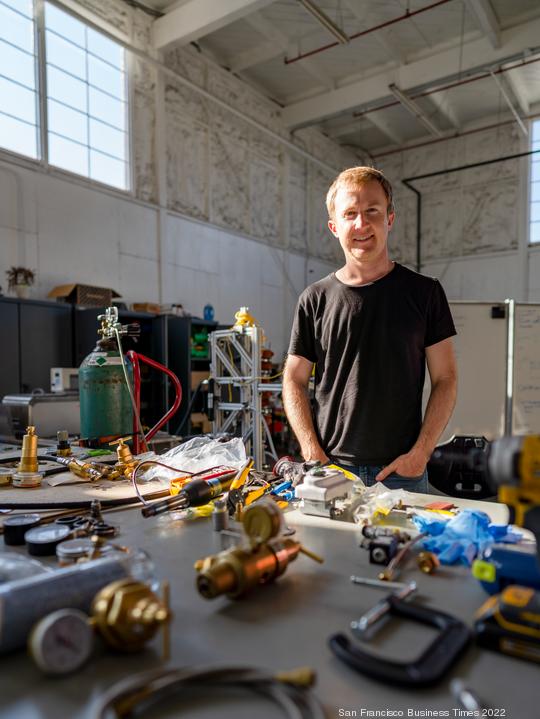
In a warehouse in the middle of San Francisco’s southeastern industrial area, a company is working on an eyebrow-raising solution to climate change: create more oil, then pump it into the ground.
Charm Industrial has developed a process that takes the leftover stacks and other biomass from cornfields in the Midwest and processes it into a “bio oil,” which it then injects back in the ground with the same technology used by the fossil fuel industry. The goal is to prevent the carbon from being released back in the atmosphere, sequestering it for up to 10,000 years.
While the technique may seem counterintuitive, major tech companies are lining up to pay for this and other premium methods of carbon removals with the intent of scaling the industry large enough to make an impact on climate change.
The company is one of many in the Bay Area and around the world devising ways to reduce the amount of carbon in the atmosphere by billions of tons a year, funded by corporations striving to meet their net zero carbon goals.
“Carbon removal is necessary and impossible,” said Tito Jankowski, the head of AirMiners, a group that aims to connect and accelerate carbon removal startups. “Every day, everybody working in this industry has to get out of bed every day and say, this is impossible, but we have to do it. So we’re going to figure out how to make it happen.”
Finding a way
Their challenge is laid out by a report by the U.N. Intergovernmental Panel on Climate Change (IPCC) from April 2022 that stated that carbon removal methods would be necessary to prevent global temperatures from rising beyond 1.5 degrees Celsius. It posited that 6 gigatons — or 6 billion metric tons — of carbon would need to be removed per year by 2050 to meet the target.
That would mean unprecedented growth for the industry.
Charm CEO Peter Reinhardt estimates that only 6,000 metric tons of carbon was removed last year, mostly by Charm and the rest by Climeworks, a Swiss company that captures carbon out of the air and turns it into minerals.
“That would mean that by 2050, the industry will have to grow by 2 million times with a compound growth rate of 65%,” he said. “I think it’s possible. It’s gonna be very hard, but it’s also a problem that the government and a lot of people are throwing their weight behind.”
The process is also very expensive. Charm currently charges $600 for each ton of carbon it removes. Like many in the sector, it has plans to reduce the price to $100, making it more practical for purchasers.
But despite the high prices, demand for carbon removal far outweighs supply thanks to companies like Stripe and Microsoft committing hundreds of millions of dollars in agreements to pre-purchase these removals from upstart companies. However, most of these companies in the carbon removal space have yet to begin actually removing carbon by the ton.
Stripe has taken the lead, offering to pay high prices to buy carbon from startups just getting off the ground. The San Francisco fintech organized a coalition of companies, which includes Alphabet and Meta, under a subsidiary Frontier to make $925 million in advanced market commitments by 2030.
“Stripe is everyone’s first customer,” Reinhardt says. “And they’ll pay practically any price per ton to help get the company started.”
But despite the heavy hitters, many believe highly technical and energy intensive techniques of carbon removal to be impractical and unable to achieve its grand scaling ambitions, especially because the demand is largely voluntary, based on the whims of corporations and their self-imposed climate goals.
“I do think carbon capture is going to get to a respectable scale, but I don’t think it’s going to come close to dealing with our issues,” said Joshua Posamentier, managing partner of the climate focused VC fund Congruent Ventures. “It’s hard to imagine there being enough money in the world or scale in the world to get us there, just from a reality basis.”
Posamentier says he would rather invest in other forms of climate change prevention that are more down to earth, such as nature-based solutions that use plants or the ocean to store carbon or turning carbon into something useful to offset the costs.
Nevertheless, carbon removals recently got a big boost from the government via the Inflation Reduction Act, which will increase the tax credit for permanent carbon removal from $50 to $180 per ton, while lowering the amount of CO2 a facility must remove to qualify for the credit from 100,000 to 1,000 tons.
There is a major caveat with the credits. They only apply to an extremely narrow segment of carbon removal techniques: direct air capture that deposits the carbon in a saline aquifer.
This would mean most of the major carbon removal companies, including Charm, would not qualify for the credits. Other Bay area companies such as Ebb Carbon, which stores carbon in the ocean, and even Heirloom, which uses the direct air capture technique but stores the carbon as minerals and not in an aquifer, also would not.
However Reinhardt believes the credits will likely broaden based on the bipartisan support of carbon removal technologies.
Another approach
On the Peninsula, San Carlos-based Ebb Carbon is just starting to get its operations running, unsurprisingly with Stripe as its first customer.
The company takes salt water runoff from desalination or nuclear power plants and uses electrochemistry to separate the salts into acids and bases. It then puts the more basic water back in the ocean, which reacts with the CO2 in the atmosphere, converting it to bicarbonate and trapping it in the ocean. This is a natural process that typically makes the ocean more acidic, but Ebb Carbon contends its process will actually reduce ocean acidification.
The company plans to begin fulfilling its carbon removal commitments by the end of this year. It has a deal with Stripe to remove 256 metric tons of carbon for $500,000 by September 2024. Ebb Carbon will begin operations by installing 100 tons per year of capacity that will be in operation by this year’s end.
“Most of the cost is from energy and then we have other operating costs and Capex you have to buy the hardware and amortize the cost of the hardware, as well,” said Ben Tarbell, co-founder and CEO of Ebb Carbon. “Over time, as renewables continue to scale and our process becomes more efficient, that portion of our costs will diminish.”
Tarbell, a former Google X engineer, has lofty goals for the company of reaching a million tons per year of capacity in the next five years and eventually reducing the price per ton down to $50 per ton. So far the company has raised $3 million in a seed funding.
This still is much more expensive than other simpler carbon offsetting techniques like tree planting, which can cost around $10 per ton depending on the project. However, tree planting has its downsides as it does not guarantee the carbon will be trapped for long due to fires, illegal logging and other detriments to the health of the forest.
“Sophisticated companies in the space are recognizing that the attributes of permanence and other differentiating characteristics of high quality carbon removals is worth the price you pay for it,” Tarbell said. “If you get 10,000-plus years of sequestration, it’s worth paying more for that than some other methods that may not actually be pulling CO2 from the atmosphere.”
THE CARBON CLAN
Here's a quick look at Bay Area carbon removal companies:
Ebb Carbon
- CEO: Ben Tarbell
- Founded: 2021
- Funding: $3 million
- HQ: San Carlos
- What they do: Developing a technique to make the ocean store more carbon while simultaneously deacidifying the waters through a proprietary electrochemical technique.
Twelve
- CEO: Nicolas Flanders
- Founded: 2015
- Funding: $192 million
- HQ: Berkeley
- What they do: Develops carbon recycling devices that can turn CO2 emissions into useful chemical products and jet fuel.
Charm Industrial
- CEO: Peter Reinhardt
- Founded: 2018
- Funding: $25.5 million
- HQ: San Francisco
- What they do: Created a process to turn biomass into an oil that is injected in the ground to prevent the carbon from being released into the atmosphere, or turn the biomass into hydrogen for fuel.
Heirloom
- CEO : Shashank Samala
- Founded: 2020
- Funding: $57.6 million
- HQ: South San Francisco
- What they do: Captures CO2 out of the air and turns it into minerals.
Living Carbon
- CEO: Madeline Hall
- Founded: 2019
- Funding: $30.13 million
- HQ: Hayward
- What they do: Devising genetically engineering plants to make them more efficient at storing carbon.



